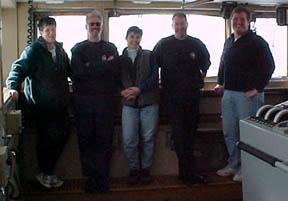
|
|
30 March, 2001
Tidbit of History
In October 1789, Secretary of the Treasury Alexander Hamilton asked the
various collectors of customs about the need for boats to protect and ensure
revenue collection. Sharp Delany, the collector at Philadelphia, replied
that he was already using a vessel for that purpose and fully endorsed the
concept. In April 1790, Hamilton asked Congress to create a Revenue Marine
service with a fleet of 10 small cutters, As the Continental Navy had been
disestablished after the Revolution and would no be reestablished until 1799
no armed federal vessels existed with which a Revenue Marine service could
be created.
On August 4, 1790, Congress passed Hamilton's Revenue Cutter Bill which
provided for construction of the following ten armed cutters: Scammel,
Massachusetts, Argus, Vigilant, General Greene, Active, Virginia, Diligence,
South Carolina, and Eagle. Hamilton's first ten armed vessels were not large
by modern standards; they ranged in length from 40-60 feet. In fact, today
we would call them boats and not cutters. Despite their small size and
absence of uniformity in design, the law and these vessels established the
precedent that all ships of the Coast Guard would forever be called cutters.
Science Observations
The Coast Guard has been instrumental in the operation of our Scientific
research. The Commanding Officer is Captain Terry Julich. He is responsible
for the overall safety and welfare of the ship and all personnel. Second in
command is the Executive Officer Commander Richard Kermond. He is
responsible for the daily routine, operation, and maintenance of the ship.
Heading the six main departments include the Engineering Officer, Operations
Officer, First Lieutenant, Supply Officer, Senior Aviator, and Marine
Science Officer.
The Engineering Department is responsible for main propulsion, electricity
and electronics, auxiliary equipment, and damage control. The Operations
Department includes Quartermasters, Marine Science Technicians, Yeomen,
Telecommunication Specialists, and the Health Services Technician. The
First Lieutenant is responsible for maintenance and operation of all topside
and internal spaces not assigned to other divisions, including small boats,
operations of cranes, lines and topside rigging. The Supply Officer is
responsible for logistics and port support as well as supplies and materials
for the ship. The Senior Aviator is responsible for the maintenance and
safe operation of the HH -65 helicopters. Special training in harsh polar
environments occurs prior to flying. The Marine Science Officer is the
primary point of contact for all science operations. Responsibility
includes safe and successful completing of all assigned scientific
operations.
Daily Update
Today's Marine Mammal flights occurred in the morning and afternoon. Ringed
and bearded seals, walruses, beluga and bowhead whales were spotted.
The temperature was 9 degrees this morning with 20-knot winds.
We completed several science stations today. We are approaching the end of
our oceanographic research. Plans include three of us leaving for St.
Lawrence Island on Sunday. Monday the remaining group will depart heading
south to Dutch Harbor. They should arrive in Dutch Harbor on April 6.
There is a strong weather condition south near the Aleutian Islands, which
may hinder departure from Dutch Harbor. We are all hopeful that it will
dissipate.
I continued to work on my packing. The challenging component is whittling
the items down to the maximum weight.

Captain Terry Julich and Kathie Stevens. <>

Picture taken inside the bridge: From left: Kathie Stevens, Executive Officer Commander Richard Kermond, Holly Kelly, Captain Terry Julich, and Jim Bartlett <>
Contact the TEA in the field at
.
If you cannot connect through your browser, copy the
TEA's e-mail address in the "To:" line of
your favorite e-mail package.
|
